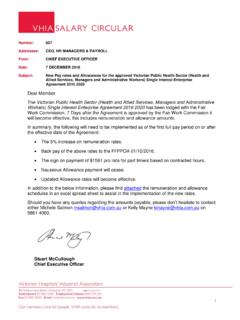Transcription of CLINICAL GUIDELINE MANAGEMENT OF PLEURX DRAINAGE …
1 CLINICAL GUIDELINEMANAGEMENT OF PLEURX DRAINAGE CATHETER SYSTEMTARGET AUDIENCEAll CLINICAL staff responsible for the care of a patient with an abdominal and Thoracic PLEURX ANY RELATED PETER MAC POLICIES, PROCEDURES OR GUIDELINES Hand Hygiene ProcedureThoracic Aspiration ProcedureAbdominal Paracentesis ProcedureAseptic Technique ProcedurePrecinct Patient Transfer ProcedurePURPOSE To provide CLINICAL guidelines for the MANAGEMENT of patients with an inserted PLEURX Catheter (abdominal and thoracic) and the subsequent use of the PLEURX DRAINAGE Kit and PLEURX Vacuum Bottles. This document will focus on appropriate patient preparation and post procedural care. The PLEURX system is indicated for intermittent, long term DRAINAGE of symptomatic, recurrent abdominal and pleural effusions. The PLEURX system is indicated for the palliation of symptoms and is intended for MANAGEMENT in the outpatient setting.
2 PRE AND POST INSERTION CARE AND PATIENT PREPARATION Ensure patient is in a hospital gown and has had appropriate analgesia (if required) prior to transfer if the patient requires light sedation, this will be managed by the CI staff. Administration of sedation in the ward setting prior to the procedure will impair the patient s ability to give informed consent (unless consent has already been obtained) FBE and clotting studies must be reviewed before procedure (platelets to be greater than 50 & INR ). If the patient has not had a recent FBE/Coags (within 6 weeks) then the procedure may need to be rebooked Contact the Cancer Imaging staff for more information if required. All inpatients require precinct transfer form MR/77 to be completed and accompany them. If patient is an inpatient being sent across to RMH, please complete Procedure Safety Checklist IP23C Identify and ensure site is appropriately marked.
3 PROCEDURE USING DRAINAGE KITNote: Procedure must only be undertaken by a suitably qualified nurse or medical officer. Hand Hygiene Procedure and Aseptic Technique Procedure should be referred to and adhered to throughout this procedure. Identify patients requiring DRAINAGE of pleural / ascitic fluid symptomatic or prescribed DRAINAGE times and discuss with patient decision to drain. Education of the patient and/or carer should take place throughout entire procedure. Set up a clean dressing trolley or workspace and gather required equipment:Equipment required Pleural: PLEURX DRAINAGE Kit containing: Plastic Vacuum Bottle with attached DRAINAGE Line (pleural DRAINAGE only) Procedure Pack containing: 3 x alcohol pads Pair of sterile gloves Valve cap Blue emergency slide clamp 4 x gauze pads Foam catheter pad Tegaderm Yellow CLINICAL waste bag Personal Protective Equipment (PPE) as requiredAbdominal DRAINAGE : PeriteX DRAINAGE kit containing: 3 x alcohol pads Pair of sterile gloves Valve cap Blue emergency slide clamp 4 x gauze pads Foam catheter pad Tegaderm Yellow CLINICAL waste bag Personal Protective Equipment (PPE) as required.
4 Attend to vital signs if clinically indicated. Attend to hand hygiene and don non sterile gloves, gently remove the dressing from over the catheter. Observe insertion site for any redness, swelling or fluid around the catheter. Discard dressing and non-sterile gloves. Hand hygiene. Pleural: Open the PLEURX DRAINAGE Kit on to the clean trolley. Set adhesive dressing aside. Open the sterile procedure pack with flap side up, and carefully unfold the blue wrapping. Open the sterile Vacuum Bottle bag and remove the bottle with the attached DRAINAGE line; place on corner of dressing trolley. Remove paper tape from line; uncoil line, ensuring that the access tip is kept sterile. If the cover had fallen off the access tip, make sure you do not touch the tip with your hands or anything : Open the PeriteX DRAINAGE kit on a clean trolley.
5 Set adhesive dressing aside. Open the sterile procedure pack with flap side up, and carefully unfold the blue wrapping. Place the DRAINAGE bag on the corner of the dressing trolley. Keep access tip sterile. If the clover had fallen off the access tip, make sure you do not touch the tip with your hands or anything non-sterile. Don sterile gloves. Roll the roller clamp on the DRAINAGE line so it is completely closed Hold the DRAINAGE line near the access tip and remove the cover with your other hand by twisting and pulling gently; set back onto sterile field. Hold the base of the catheter valve and remove the cap by twisting it counter clockwise and pulling gently. Discard the cap. While holding the base of the catheter valve in one hand, clean around the valve opening with an alcohol swab (ensure opening has been cleaned a full 360 degrees) Continue holding the catheter near the valve.
6 Pick up the DRAINAGE line with your other hand and insert the access tip securely into the catheter valve. You will hear a click when the access tip and valve are locked together. Keep the valve on the PLEURX Catheter and access tip on the DRAINAGE line sterile. Keep them away from other objects to help avoid the DRAINAGE bag or bottle is below the site of DRAINAGE . DRAINAGE of Fluid (Pleural): The support clip on the vacuum bottle ensures that the vacuum seal on the bottle is not broken before you are ready. Remove the support clip by grasping the upper part of the flange and pulling outward. Hold the bottle steady with one hand and push the white T plunger down with the other hand to puncture the foil seal. The vacuum in the bottle will pull the flexible bottle cap down. Check vacuum of bottle is intact.
7 Slowly release the roller clamp on the DRAINAGE line to begin DRAINAGE . Fluid will flow into the vacuum bottle. You can control the flow rate by adjusting the roller clamp. When the fluid is almost completely drained, the flow into the bottle may slow down, you may be able to observe bubbles or the sound might change. When the flow stops or the 500mL bottle is filled, adjust the roller clamp on the DRAINAGE line so that it is completely closed. DRAINAGE will usually take 5 15 minutes. The patient may experience some pain or discomfort when draining fluid. Adjusting the roller clamp to slow or stop the flow of fluid for a few minutes may lessen the pain. Consider use of analgesia pre medication for subsequent drainages. DRAINAGE of fluid (Abdominal): Attach DRAINAGE line in one gloved hand and the catheter valve in the other, pull the access tip out of the valve in a firm, smooth motion.
8 Set the DRAINAGE line down. Clean the valve with an alcohol swab, ensuring standard aseptic non touch technique is adhered to as per Aseptic Technique Procedure. Slowly release the roller clamp DRAINAGE line to begin DRAINAGE . Fluid will flow into the PeriteX bag. You can control the flow rate by adjusting the roller clamp. When the fluid is almost completely drained, the flow into the bag may slow down. When the flow stops or the 1,000mL bag is filled, adjust the roller clamp on the DRAINAGE line so that it is completely closed. DRAINAGE will usually take 5-15 minutes. The patient may experience some pain or discomfort when draining fluid. Adjusting the roller clamp to slow or stop the flow of fluid for a few minutes may lessen the pain. Consider use of analgesia pre medication for subsequent volumes:The timing and volume of pleural or ascitic fluid to be drained should be determined by the patient s symptoms and on the orders of the patients home team.
9 This information should be documented & discussed with the family. Care must be taken not to drain large volumes of fluid too quickly to prevent the patient from becoming hypotensive. PLEURX Product Information Recommendations re DRAINAGE volumes:Pleural DRAINAGE it is recommended that no more than 1000mL of fluid is drained from chest at any one timeAbdominal DRAINAGE - it is recommended that no more than 2000mL of fluid is drained from abdomen at any one time Please Note this is a guide only - it is recommended that if large volumes of fluid are to be drained this should happen over a period of time and the patient closely monitored for any adverse outcomes Placing a New around the catheter site with remaining alcohol swab. Perform skin inspection, observing for signs and symptoms of infection and exudates.
10 Wound swab and / or fluid MCS if clinically the foam catheter pad around the the catheter into loops and place it over the foam the catheter with all gauze swabs gloves. Hand the self-adhesive dressing and peel away the larger of the two pieces of paper backing from the the dressing over the gauze and press it waterproof occlusive dressing over the gauze is covered and the dressing is Complications:ComplicationSigns and SymptomsManagementPneumothorax (pleural)Sudden onset of; chest pain tachycardia cough dyspnea tachypnea nasal flaringMET call if vital signs indicate needMedical reviewRe-inflation of lung through interventions such as intercostal catheterRe-Expansion Pulmonary Oedema (pleural) Persistent severe cough chest pain frothy sputum dyspnea tachycardia tachypnea hypoxemiaMET call if appropriateAdminister supplemental oxygenMay require ventilationHypotension/Hypovolemic shock if large amounts of fluid are drained to quickly (pleural & ascitic) Dizziness Light headed Weakness Blurred vision Fatigue CollapseMET call if vital signs indicate needClamp DrainageClinical Review or MET call if appropriateInfection sutures or wound site (pleural & Ooze RednessMedical reviewCulture and sensitivity of woundascitic) Pain FebrileAntibiotics as prescribedPain (pleural & ascitic)

